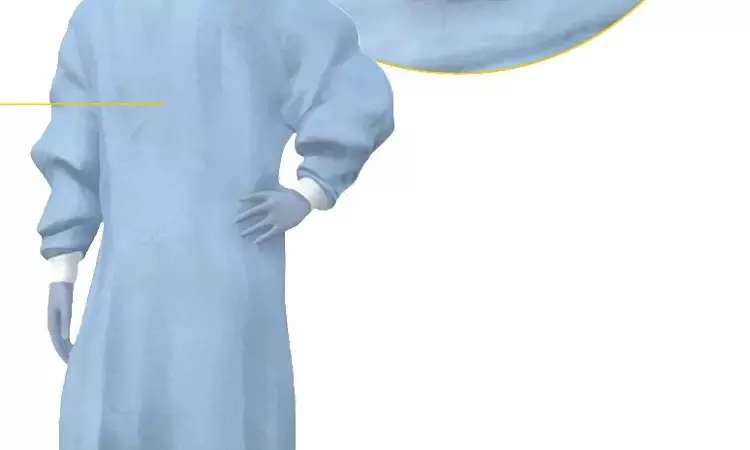- Home
- Medical news & Guidelines
- Anesthesiology
- Cardiology and CTVS
- Critical Care
- Dentistry
- Dermatology
- Diabetes and Endocrinology
- ENT
- Gastroenterology
- Medicine
- Nephrology
- Neurology
- Obstretics-Gynaecology
- Oncology
- Ophthalmology
- Orthopaedics
- Pediatrics-Neonatology
- Psychiatry
- Pulmonology
- Radiology
- Surgery
- Urology
- Laboratory Medicine
- Diet
- Nursing
- Paramedical
- Physiotherapy
- Health news
- Fact Check
- Bone Health Fact Check
- Brain Health Fact Check
- Cancer Related Fact Check
- Child Care Fact Check
- Dental and oral health fact check
- Diabetes and metabolic health fact check
- Diet and Nutrition Fact Check
- Eye and ENT Care Fact Check
- Fitness fact check
- Gut health fact check
- Heart health fact check
- Kidney health fact check
- Medical education fact check
- Men's health fact check
- Respiratory fact check
- Skin and hair care fact check
- Vaccine and Immunization fact check
- Women's health fact check
- AYUSH
- State News
- Andaman and Nicobar Islands
- Andhra Pradesh
- Arunachal Pradesh
- Assam
- Bihar
- Chandigarh
- Chattisgarh
- Dadra and Nagar Haveli
- Daman and Diu
- Delhi
- Goa
- Gujarat
- Haryana
- Himachal Pradesh
- Jammu & Kashmir
- Jharkhand
- Karnataka
- Kerala
- Ladakh
- Lakshadweep
- Madhya Pradesh
- Maharashtra
- Manipur
- Meghalaya
- Mizoram
- Nagaland
- Odisha
- Puducherry
- Punjab
- Rajasthan
- Sikkim
- Tamil Nadu
- Telangana
- Tripura
- Uttar Pradesh
- Uttrakhand
- West Bengal
- Medical Education
- Industry
Surgical Helmet System hoods in joint arthroplasty may not completely sterile after it has been applied: study

The incidence of prosthetic joint infection (PJI) is increasing, coincident with the rising volume of joint arthroplasty being performed. With recent controversy regarding the efficacy of surgical helmet systems (SHS) in pre venting infection, the focus has turned to the correct donning techniques and usage of surgical hoods. McAleese et al conducted a study to compare the bacterial contamination of the operating surgeon’s gloves after two common donning techniques of SHS hoods.
The study was conducted at ‘Tallaght University Hospital, Dublin, Ireland’. It has been published in ‘Arthroplasty’ journal.
The bacterial contamination rate was quantified using colony-forming units (CFUs), with 50 trials per formed per donning technique. Samples were cultured on 5% Columbia blood agar in ambient air at 37 °C for 48 h and all subsequent bacterial growth was identified using a MALDI-TOF mass spectrometer. In Group 1, the operating surgeon donned their colleague’s hood. In Group 2, the operating surgeon had their hood applied by a non-scrubbed colleague. After each trial, the operating surgeon immediately inoculated their gloves onto an agar plate. The immediate sterility of 50 SHS hoods was assessed at two separate zones—the screen (Zone 1) and the neckline (Zone 2).
Key findings of the study were:
• There was no significant difference in contamination rates between the two techniques (3% vs. 2%, P=0.99) or between right and left glove contamination rates.
• Immediately after donning, 6/50 (12%) of SHS hoods cultured an organism.
• Contamination rates at both the face shield and neckline zones were equivalent.
• The majority of bacteria cultured were Bacillus species.
The authors concluded that – “We found no statistically significant difference between the bacterial contamination rates of the operating surgeon’s gloves using two common techniques of SHS hood application. These trials were performed under laminar airflow with late fan activation. We advise that extreme care should be exercised when the operating surgeon assists donning a surgical colleague to negate the risk of inadvertent contamination. Importantly, based on our results, the SHS hood should not be presumed to be completely sterile after it has been applied and we recommend against adjusting it intraoperatively. Further studies examining the clinical significance of these results are warranted. Research comparing different donning techniques using different brands of gloves and sterile hoods may further enlighten this area.”
Further reading:
Surgical helmet systems in total joint arthroplasty: assessment of hood sterility and donning technique
McAleese et al
Arthroplasty (2023) 5:53
https://doi.org/10.1186/s42836-023-00212-4
MBBS, Dip. Ortho, DNB ortho, MNAMS
Dr Supreeth D R (MBBS, Dip. Ortho, DNB ortho, MNAMS) is a practicing orthopedician with interest in medical research and publishing articles. He completed MBBS from mysore medical college, dip ortho from Trivandrum medical college and sec. DNB from Manipal Hospital, Bengaluru. He has expirence of 7years in the field of orthopedics. He has presented scientific papers & posters in various state, national and international conferences. His interest in writing articles lead the way to join medical dialogues. He can be contacted at editorial@medicaldialogues.in.
Dr Kamal Kant Kohli-MBBS, DTCD- a chest specialist with more than 30 years of practice and a flair for writing clinical articles, Dr Kamal Kant Kohli joined Medical Dialogues as a Chief Editor of Medical News. Besides writing articles, as an editor, he proofreads and verifies all the medical content published on Medical Dialogues including those coming from journals, studies,medical conferences,guidelines etc. Email: drkohli@medicaldialogues.in. Contact no. 011-43720751


